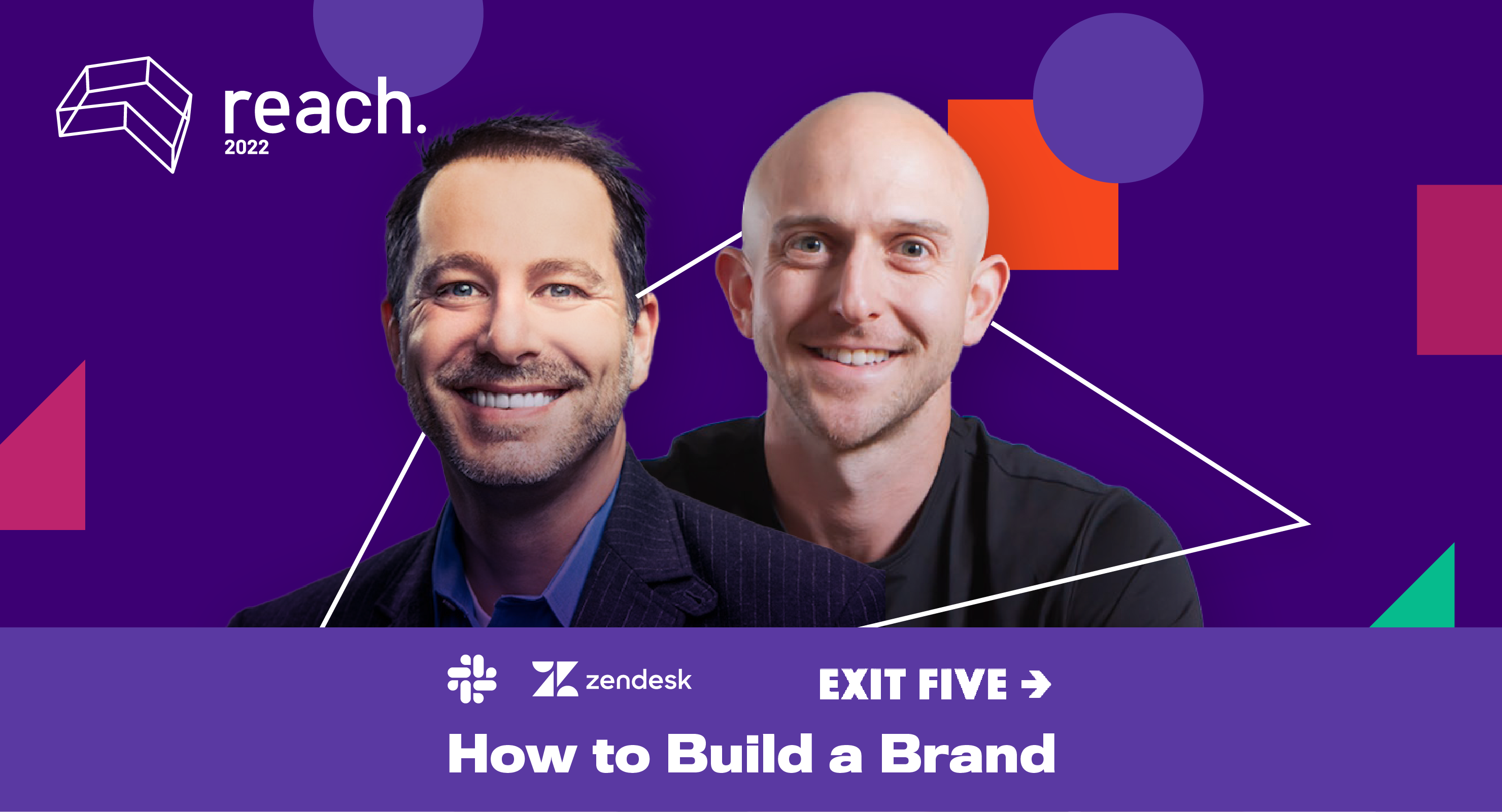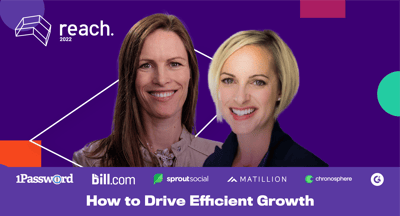December 8, 2022
.png?width=400&height=150&name=Copy%20of%20G2%20Image%20(1).png) by Shreya Mattoo / December 8, 2022
by Shreya Mattoo / December 8, 2022

“The brand is a fire that drives customers.” - Bill Macaitis
On December 1st, we gathered once again for Reach 2022, G2’s digital conference. Reach hosted multiple guest speakers who have established their expertise in the business-to-business (B2B) software market.
It also featured a 30-minute fireside chat on how to build a brand in an economic downturn with Bill Macaitis, former CMO at Slack and Zendesk, and Dave Gerhardt, founder and CEO of Exit Five.
Even in the aftermath of the COVID-19 pandemic, B2B brands have managed to level their growth. But how? Both marketers and consumers are responsible for it. Consumers seek solutions. Brands seek intent.
A brand allows consumers to recognize and interact with a particular product or service. It is a company’s visual identity in an online marketplace. A brand comprises a logo, slogan, trademark registration, domain name, colors, or content on a company's website or social media accounts. Representing your brand in a personalized way increases your reliability in the market and directs more people toward your channel.
Bill Macaitis has been in the brand marketing and consumer industry for over 20 years, with experience working at companies like Slack, Salesforce, and Zendesk. That’s one of the reasons he calls himself an “online marketing nerd.”
Macaitis now works as a marketing and strategy advisor to prominent SaaS brands. For him, the brand simply translates into “service for the people.”
Macaitis says that a brand is a “volatile” term and does not get enough recognition in the B2B marketplace. While B2C companies go gaga over their market spending, advertisements, and content promotion, B2B pushes it away for the almighty customer.
Different people have different perceptions of B2B brand marketing. Some people follow it religiously, while others think it’s a scam. But brand marketing is something you do for your brand, regardless of the output. Accurate and targeted brand positioning of your products sets the stage for future conversions and sales deals.
Marketing decisions can’t be taken in a vacuum, so Macaitis believes certain steps must be taken before beginning to build a brand.
As a preset, companies must ensure everyone across departments is familiar with the launch product. Active interactions and internal data distribution is the right way to kickstart a marketing campaign. This 8-step brand-building strategy will keep you on the best path.
Bill Macaitis shares a part of his journey with Slack product marketing and demand gen teams, “Back then, we were just looking for ways to disrupt the market.”
However, it wasn’t easy for Slack to make a dent, as Gmail and Outlook had already outclassed everyone else.
While running a Slack marketing campaign, Macaitis considered the concept of consumer intent. His strategy was to make space for Slack in the mind of existing target groups of competitors. He ran various product satisfaction surveys, sought feedback, and measured consumer satisfaction. The GTM model didn't bring in the expected MQLs but gave Macaitis a great knowledge of the existing market.
Slack’s main focus was not to capitalize on a budget but to ensure 100% customer satisfaction. Here’s how they crafted a future-proof GTM strategy.
For Macaitis, B2B marketing has always been old-fashioned. Interacting with consumers through different channels feels like a sterile process. Plus, racking up consumer data in large numbers is difficult, time-consuming, and misleading.
However, he believes that anything can be achieved with a bunch of effective marketing tools and an organizational framework.
He also says that for some brands, marketers go by the analogy of “white background, black text" for websites. A little color never hurt anyone. Brands shouldn’t shy away from different color palettes against website backgrounds.
Another point Macaitis makes is letting your customers keep a foot in the door. At any survey stage, they should feel free to walk out. Your survey forms should include the “cancel” and the “next” options. An efficient user experience helps you earn genuine customers.
While creating a marketing plan for Slack, Macaitis’s team reanalyzed the critical drawbacks of Gmail and Outlook. Both produced 90% consumer awareness but 0% sentiment. He extrapolated that the best way to retain consumers would be empathizing with consumer challenges through content.
"How you feel about a brand is a great litmus test for sales."
Bill Macaitis
Former CMO, Slack and Zendesk
Both Gerhardt and Macaitis agree that design is one of the main strengths of G2’s brand marketing. The succinct logo, catchy tagline, bold colors, and neat content layout draw attention.
Gerhardt adds that the appearance of a brand has a lot of market value. Nothing works if you have a great product at stake without a design vision.
For G2, the recency, quality, and length of software reviews on category pages can increase market presence. Finding a way to present this data on the website is essential. Customers want to be seen, heard, and prioritized. Creating a diverse forum of software buyers should be the next call for G2.
Further, arranging community gatherings, webinars, and events broadens G2’s PEAK vision: Performance, Entrepreneurship, Authenticity, and Kindness.
G2 wears its heart on its sleeve. And it needs to keep it there.
Running simple surveys about product satisfaction can also uplift the G2 brand. Providing a rating mechanism or “thumbs up/down” button motivates buyers to make the right choice.
As a pioneer in the software industry, Gerhardt feels that buying software is a multifaceted process. If you’re buying or implementing software, you need to make a lot of arrangements. Approximately 10 to 12 people are part, which can take 3 to 6 months. Because of the longevity of the buying process, no one can afford an error.
If you’re a buyer interested in audio hosting software, you must ask a couple of questions. Look for expert opinions on the best audio hosting software, check for online reviews, and then decide.
Macaitis and Gerhardt emphasize the essence of "word-of-mouth" marketing in the software industry. Buyers who invest a huge chunk of money in SaaS cannot be duped. Their buying decision comprises many layers: leaning into positive reviews, exploring success stories, and consulting software experts.
As sellers, these are the points you need to highlight about your brand. Word of mouth is a powerful tool in today’s marketing scene. Approximately 15,000 MarTech tools are taking up space in the industry, and word of mouth can still rise above all that noise.
Tick all your consumer's requirements before they point fingers at your solution. If you have bad reviews or ratings, try to better them. The key is to not hide your ratings but ensure you bolster your brand services to the extent that there are no dissatisfactions.
Chief marketing officers (CMOs) need to keep an “employee-centric approach” to predict their marketing goals, knowing that employees can create a buzz for your brand.
Set a fixed marketing goal you want to achieve and work on it with your team. Don't waste your time gathering a million ideas. This will only distract you from what you strive to achieve for your business.
Macaitis calls a marketing campaign a display of funnel metrics. “We put on funnel blinders and measure funnel metrics,” he says. This means that generating traffic, MQLs, and SQLs mostly serve as “funnel blinders” that take focus away from the mutual goal: solving the struggles of your customers.
Macaitis suggests that CMOs follow these practices to set their marketing goals in advance.
When asked this question, Macaitis and Gerhardt both chuckle. Every time the economy drops, people start worrying about their online audiences. These two seasoned marketers fail to understand why product companies don’t prioritize them from the very beginning.
After all, they bring in a major chunk of sales.
Macaitis feels that having a “data measurement” mindset is imperative to survive the cacophony of the economic downturn. If people aren’t engaging with you on your website, they might be checking out your commercial on wired media, or maybe they’re already in the middle of the deal. To convert high-intent leads, you must have a bird’s-eye view of your consumer base.
Don’t lose your ground in the quest to gain traffic. When you have a strong vision, people’s sentiments will change automatically. It won’t require you to build a brand case and spend “X” dollars on billboards or below-the-line advertising. Budget-friendly, low-scale branding activities can have a similar impact.
Customers are quick wins. A little potion of personalization, love, and empathy makes them gravitate toward you. Instead of spending a fortune on paid advertising, craft thought leadership content that would help them.
Gerhardt explains that the success of marketing channels like TikTok, YouTube, and Instagram has spellbound him. However, he still feels “to each their own”. Social media can be a great medium for some brands to acquire leads and sell products, but it might not work for others.
He also says that you can’t do everything in a single blow. Running campaigns on different channels can make you lose focus on what you’re selling. Most leads only come in from 2 or 3 big bets, so other campaigns would not succeed.
Macaitis talks about his colleague, Ana, who had fantastic presentation skills and tone of voice. Consequently, her skills were utilized everywhere: on the signup pages, search ads, and blogs.
Don’t shy away from telling the truth to your employees. If they’re great at something, let them know. Conversely, you must tell them if they’re not great at something. That’s what will capture the essence of true branding in 2023.
After 15 years in brand marketing, Macaitis is now most excited about “product-led growth.” According to Macaitis, scaling the latest tech on the market floor would be a game changer for the B2B sector.
As marketers, you need to roll up your sleeves and get your hands dirty to drive value for your brands. Be on the top of your game, sharpen your expertise, and don’t let anyone second guess you or your skillset.
When you run your cause with empathy and creativity, you’ll give your consumers the validation they long for. The returns will be manifold if you stay true to your audience and yourself.
It's raining consumers in the B2B market. Know how to leverage your consumer data and market trends to their full potential with a detailed buyer intent guide.
Shreya Mattoo is a former Content Marketing Specialist at G2. She completed her Bachelor's in Computer Applications and is now pursuing Master's in Strategy and Leadership from Deakin University. She also holds an Advance Diploma in Business Analytics from NSDC. Her expertise lies in developing content around Augmented Reality, Virtual Reality, Artificial intelligence, Machine Learning, Peer Review Code, and Development Software. She wants to spread awareness for self-assist technologies in the tech community. When not working, she is either jamming out to rock music, reading crime fiction, or channeling her inner chef in the kitchen.
In 2019, there were only 21 products in the AI Writing Assistant market.
 by Sydney Sloan
by Sydney Sloan
Banking on demand generation to keep your business afloat?
.png) by Shreya Mattoo
by Shreya Mattoo
Nothing stays the same.
 by Mara Calvello
by Mara Calvello
In 2019, there were only 21 products in the AI Writing Assistant market.
 by Sydney Sloan
by Sydney Sloan
Banking on demand generation to keep your business afloat?
.png) by Shreya Mattoo
by Shreya Mattoo


